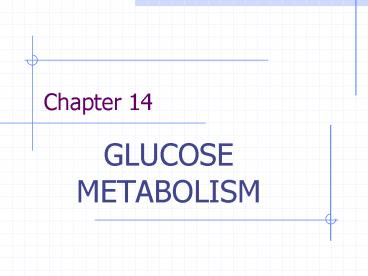GLUCOSE METABOLISM - PowerPoint PPT Presentation
1 / 15
Title:
GLUCOSE METABOLISM
Description:
Glucose 2 pyruvate 2 ATP. Pathway common in all organisms-10 common enzymes. Also known as the 'Embden-Meyerhof-Parnas Pathway' after researchers from the 1940's ... – PowerPoint PPT presentation
Number of Views:271
Avg rating:3.0/5.0
Title: GLUCOSE METABOLISM
1
Chapter 14
- GLUCOSE METABOLISM
2
OVERVIEW OF GLYCOLYSIS
- Key energy-production pathway
- Glucose? 2 pyruvate 2 ATP
- Pathway common in all organisms-10 common enzymes
- Also known as the Embden-Meyerhof-Parnas
Pathway after researchers from the 1940s
3
OVERVIEW OF GLYCOLYSIS
- Glucose2NAD2ADP 2 Pi?2pyruvate2NADH2ATP
- Stage 1 energy investment rxns 1-5 consumes 2
ATP - Stage 2 energy recovery rxns 6-10 generates 4
ATP and 2 NADH - NET 2 ATP and 2 NADH
4
OVERVIEW OF GLYCOLYSIS
- PATHWAY Figure 14.1
5
REACTIONS OF GLYCOLYSIS
- Enzyme 1 Hexokinase
- Glucose ATP Mg2 ? Glucose-6-P ADP
- Mg is essential for shielding ?, ?, and/or ?
phosphate charges during nucleophilic attack of P
by Glucose - Substrate binding closes enzyme active cleft,
excluding water, moving ATP nearer to glucose
molecule (catalysis by proximity effect) and
expediting the nucleophilic reaction
6
REACTIONS OF GLYCOLYSIS
- Enzyme 2 Phosphoglucose Isomerase (PGI)
- Glucose-6-P ? Fructose-6-P
- Aldose (pyranose) to Ketose (furanose) with ring
opening and reclosing - Classic acid-base enzyme catalysis mechanism
involving a Lys-H donor and Glu-H acceptor
(Figure 14.3)
7
REACTIONS OF GLYCOLYSIS
- Enzyme 3 Phosphofructokinase (PFK)
- Fructose-6-P ATP Mg2 ? Fructose-1-6-BisP
- Bis versus Di because PO4 not attached to each
other - Mechanism very similar to hexokinase
nucleophilic attack of Mg2-shielded ATP - Key control point (later - AMP, ATP, Citrate)
8
REACTIONS OF GLYCOLYSIS
- Enzyme 4 Aldolase
- Fructose-1-6-BisP ? G3P DHAP
- Glucose atoms 1-3 3, 2, 1 of DHAP Glucose
atoms 4-6 1, 2, and 3 of G3P - Aldol cleavage requirements (C2 carbonyl and C4
hydroxyl) makes clear the need for the
aldose-ketose isomerization - Enzyme shows diversity in mechanism. Many have
Schiff base (sugar keto carbon amine) (covalent
catalysis) intermediates (fig 14-5) or metal ion
catalysis
9
REACTIONS OF GLYCOLYSIS
- Enzyme 5 Triosphosphate Isomerase (TPI or
TIM) - DHAP ? G3P
- Enediol intermediate for isomerization
- Acid-base catalysis like other isomerase, using
Glu and His - Stereoelectronic control prevents C3-phosphate
elimination, which would be favored product in
non-enzymatic reaction - Perfect Enzyme rate is diffusion limited
- Equilibrium favors DHAP coupled rxns with
following steps keep conversion to C3P moving
forward
10
REACTIONS OF GLYCOLYSIS
- Enzyme 6 Glyceraldehyde-3-Phosphate
Dehydrogenase (GAPDH) - G3P NAD Pi ? 1,3 BPG NADH H
- Aldehyde oxidation (exergonic) drives synthesis
of high-energy acyl phosphate (high-energy cpd) - Cys forms covalent intermediate, thiohemiacetal,
which is oxidized to a thioester - Net Rxn is endergonic
11
REACTIONS OF GLYCOLYSIS
- Enzyme 7 Phosphoglycerokinase (PGK)
- 1,3 BPG ADP Mg2 ? 3-PG ATP
- Substrate binding cleft swings closed after
substrate binding to provide a water-free
environment (proximity effect like hexokinase) - Couples with G3PDH to pull that reaction forward
- Substrate level phosphorelation directly yields 1
ATP
12
REACTIONS OF GLYCOLYSIS
- Enzyme 8 Phosphoglycerate Mutase (PGM)
- 3PG ? 2PG
- Phosphorelated His on enzyme catalyzes the
isomeration (proximity effect) - 2,3 BPG intermediate occasionally diffuses off
the enzyme this is the factor that binds
deoxyhemoglobin to lower its binding affinity but
the majority of cpd produced in RBCs using
separate enzyme
13
REACTIONS OF GLYCOLYSIS
- Enzyme 9 Enolase
- 2PG ? PEP H2O
- Hydrolysis to form second high energy
intermediate - Metal Ion Catalysis
14
REACTIONS OF GLYCOLYSIS
- Enzyme 10 Pyruvate Kinase (PK)
- PEP ADP ? Pyruvate ATP
- Hydrolysis and tautomerization of second high
energy intermediate - Requires both K and 2 Mg2 for ADP nucleophilic
attack of PEP - Enolase Rxn was, thus, required to provide high
energy compound capable of ATP generation
15
REACTIONS OF GLYCOLYSIS
- SUMMARY
- Energy investment in stage 1 recaptured in stage
2 - Products
- ATP net 2 ATP/glucose
- NADH 2 NADH/glucose to be regenerated by
electron transport pathway with ATP production - PYRUVATE 2 pyruvates go to Citric Acid Cycle
(aerobic) or lactate (anaerobic-regenerates NAD)

